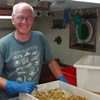General Description
Fourth segment (merus) of larger claw (cheliped) with hook on lower margin; sixth segment (propodus) excavate in gape in male only; last segment (dactylus) with 2 strong teeth in male, simple in female. Tail fan (telson) as wide as long, shorter than uropods. Up to 4.5 cm long.
Biology
This small but abundant species is so named because it prefers sandy sediments (unlike other species which prefer deeper muddy bays). The combination of a blade-like lobe on the arm of the larger claw and a squarish telson differentiate this species from Callianassa limosa. The species is an active burrower important in sedimentary nutrient dynamics. It makes a complex burrow and feeds on the sediment it excavates.
Habitat
Intertidal to shallow subtidal sandflats, often estuarine, depths to 25 m.
Soft substrates
Distribution guide
Southern temperate oceans, including south-eastern Australia.
Species Group
Prawns, shrimps, lobsters › Ghost and mud shrimps
Depth
Shore (0-1 m)
Shallow (1-30 m)
Water Column
Max Size
4.5 cm
Diet
Organic matter
Harmful
Not harmful but a nip from large claws could be painful
Commercial Species
No
Global Dispersal
Native to Australia
Species Code
MoV 1005
Conservation Status
- DSE Advisory List : Not listed
- EPBC Act 1999 : Not listed
- IUCN Red List : Not listed







